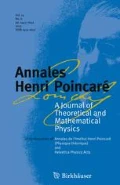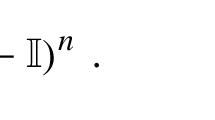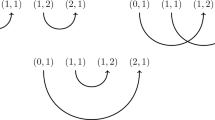Abstract
This work presents some results about Wick polynomials of a vector field renormalization in locally covariant algebraic quantum field theory in curved spacetime. General vector fields are pictured as sections of natural vector bundles over globally hyperbolic spacetimes and quantized through the known functorial machinery in terms of local \(*\)-algebras. These quantized fields may be defined on spacetimes with given classical background fields, also sections of natural vector bundles, in addition to the Lorentzian metric. The mass and the coupling constants are in particular viewed as background fields. Wick powers of the quantized vector field are axiomatically defined imposing in particular local covariance, scaling properties, and smooth dependence on smooth perturbation of the background fields. A general classification theorem is established for finite renormalization terms (or counterterms) arising when comparing different solutions satisfying the defining axioms of Wick powers. The result is specialized to the case of general tensor fields. In particular, the case of a vector Klein–Gordon field and the case of a scalar field renormalized together with its derivatives are discussed as examples. In each case, a more precise statement about the structure of the counterterms is proved. The finite renormalization terms turn out to be finite-order polynomials tensorially and locally constructed with the backgrounds fields and their covariant derivatives whose coefficients are locally smooth functions of polynomial scalar invariants constructed from the so-called marginal subset of the background fields. The notion of local smooth dependence on polynomial scalar invariants is made precise in the text. Our main technical tools are based on the Peetre–Slovák theorem characterizing differential operators and on the classification of smooth invariants on representations of reductive Lie groups.
Similar content being viewed by others
References
Allen, B., Folacci, A.: Massless minimally coupled scalar field in de Sitter space. Phys. Rev. D 35, 3771–3778 (1987)
Anderson, I.M., Torre, C.G.: Two component spinors and natural coordinates for the prolonged Einstein equation manifolds. Tech. Rep., Utah State University (1994). Unpublished
Anderson, I.M., Torre, C.G.: Classification of local generalized symmetries for the vacuum Einstein equations. Commun. Math. Phys. 176, 479–539 (1996). arXiv:gr-qc/9404030
Atiyah, M., Bott, R., Patodi, V.K.: On the heat equation and the index theorem. Invent. Math. 19, 279–330 (1973)
Bär, C., Fredenhagen, K. (eds.): Quantum field theory on curved spacetimes: concepts and mathematical foundations. Lecture Notes in Physics, vol. 786. Springer (2009)
Benini, M., Dappiaggi, C.: Models of free quantum field theories on curved background. In: Brunetti, R., Dappiaggi, C., Fredenhagen, K., Yngvason, J. (eds.) Advances in Algebraic Quantum Field Theory, Ch. 3. Springer, Berlin (2015)
Brouder, C., Dang, N .V., Laurent-Gengoux, C., Rejzner, K.: Properties of field functionals and characterization of local functionals. J. Math. Phys. 59, 023508 (2017). arXiv:1705.01937
Brunetti, R., Fredenhagen, K.: Microlocal analysis and interacting quantum field theories: renormalization on physical backgrounds. Commun. Math. Phys. 208, 623–661 (2000). arXiv:math-ph/9903028
Brunetti, R., Fredenhagen, K., Verch, R.: The generally covariant locality principle-a new paradigm for local quantum field theory. Commun. Math. Phys. 237, 31–68 (2003). arXiv:math-ph/0112041
Christoffel, E.B.: Über die Transformation der homogenen Differentialausdrücke zweiten Grades. J. Reine Angew. Math. 70, 46–70 (1869). http://eudml.org/doc/148073
Dappiaggi, C., Drago, N.: Constructing Hadamard states via an extended Møller operator. Lett. Math. Phys. 106, 1587–1615 (2016). arXiv:1506.09122
Drago, N., Gérard, C.: On the adiabatic limit of Hadamard states. Lett. Math. Phys. 107, 1409–1438 (2017). arXiv:1609.03080
Drago, N., Hack, T.-P., Pinamonti, N.: The generalised principle of perturbative agreement and the thermal mass. Ann. Henri Poincaré 18, 807–868 (2017). arXiv:1502.02705
Fredenhagen, K., Rejzner, K.: Batalin-Vilkovisky formalism in the functional approach to classical field theory. Commun. Math. Phys. 314, 93–127 (2012). arXiv:1101.5112
Fulton, W.: Young Tableaux: With Applications to Representation Theory and Geometry. London Mathematical Society Student Texts, vol. 35. Cambridge University Press, Cambridge (1996)
Gilkey, P.B.: Curvature and the eigenvalues of the Laplacian for elliptic complexes. Adv. Math. 10, 344–382 (1973)
Goodman, R., Wallach, N.R.: Symmetry, Representations, and Invariants. Graduate Texts in Mathematics, vol. 255. Springer, New York (2009)
Hack, T.-P., Pinamonti, N.: Cosmologial application of algebraic quantum field theory. In: Brunetti, R., Dappiaggi, C., Fredenhagen, K., Yngvason, J. (eds.) Advances in Algebraic Quantum Field Theory, Ch. 6. Springer, Berlin (2015)
Hollands, S.: Renormalized quantum Yang–Mills fields in curved spacetime. Rev. Math. Phys. 20, 1033–1172 (2008). arXiv:0705.3340
Hollands, S., Wald, R.M.: Local Wick polynomials and time ordered products of quantum fields in curved spacetime. Commun. Math. Phys. 223, 289–326 (2001). arXiv:gr-qc/0103074
Hollands, S., Wald, R.M.: Existence of local covariant time ordered products of quantum fields in curved spacetime. Commun. Math. Phys. 231, 309–345 (2002). arXiv:gr-qc/0111108
Hollands, S., Wald, R.M.: Conservation of the stress tensor in perturbative interacting quantum field theory in curved spacetimes. Rev. Math. Phys. 17, 227–311 (2005). arXiv:gr-qc/0404074
Jentsch, T.: The jet isomorphism theorem of pseudo-Riemannian geometry. arXiv:1509.08269
Khavkine, I., Moretti, V.: Algebraic QFT in curved spacetime and quasifree Hadamard states: an introduction. In: Brunetti, R., Dappiaggi, C., Fredenhagen, K., Yngvason, J. (eds.) Advances in Algebraic Quantum Field Theory, Ch. 5. Springer, Berlin (2015)
Khavkine, I., Moretti, V.: Analytic dependence is an unnecessary requirement in renormalization of locally covariant QFT. Commun. Math. Phys. 344, 581–620 (2016). arXiv:1411.1302 [gr-qc]
Kolař, I., Michor, P.W., Slovák, J.: Natural Operations in Differential Geometry. Springer, Berlin (1993)
Luna, D.: Fonctions différentiables invariantes sous l’opération d’un groupe réductif. Ann. Inst. Fourier 26, 33–49 (1976)
Michor, P.W.: Topics in Differential Geometry. American Mathematical Society, Providence, RI (2008)
Parlett, B.N.: The (matrix) discriminant as a determinant. Linear Algebra Appl. 355, 85–101 (2002)
Penrose, R.: A spinor approach to general relativity. Ann. Phys. 10, 171–201 (1960)
Procesi, C.: Lie Groups: An Approach Through Invariants and Representations. Universitext. Springer, New York (2007)
Richardson, R.W.: Principal orbit types for real-analytic transformation groups. Am. J. Math. 95, 193–203 (1973)
Richardson, R.W., Slodowy, P.J.: Minimum vectors for real reductive algebraic groups. J. Lond. Math. Soc. 42, 409–429 (1990)
Rumberger, M.: Finitely differentiable invariants. Math. Z. 229, 675–694 (1998)
Sahlmann, H., Verch, R.: Microlocal spectrum condition and Hadamard form for vector-valued quantum fields in curved spacetime. Rev. Math. Phys. 13, 1203–1246 (2001). arXiv:math-ph/0008029
Schambach, M., Sanders, K.: The Proca field in curved spacetimes and its zero mass limit. arXiv:1709.01911 [math-ph]
Schouten, J.A.: Ricci-calculus: An Introduction to Tensor Analysis and Its Geometrical Applications. Grundlehren der mathematischen Wissenschaften, vol. 10, 2nd edn. Springer, Berlin (1954)
Slovák, J.: Peetre theorem for nonlinear operators. Ann. Global Anal. Geom. 6, 273–283 (1988)
Slovák, J.: On invariant operations on pseudo-Riemannian manifolds. Comment. Math. Univ. Carol. 33, 269–276 (1992). http://eudml.org/doc/247392
Stephani, H., Kramer, D., MacCallum, M., Hoenselaers, C., Herlt, E.: Exact Solutions of Einstein’s Field Equations. Cambridge University Press, Cambridge (2003)
Stoetzel, H.: Quotients of real reductive group actions related to orbit type strata. PhD thesis, Ruhr-Universitat Bochum (2008). http://nbn-resolving.de/urn/resolver.pl?urn=urn:nbn:de:hbz:294-23168
Thomas, T.Y.: Differential Invariants of Generalized Spaces. CUP, Cambridge (1934)
Wald, R.M.: General Relativity. The University of Chicago Press, Chicago (1984)
Zahn, J.: The renormalized locally covariant Dirac field. Rev. Math. Phys. 26, 1330012 (2014). arXiv:1210.4031
Acknowledgements
The authors are grateful to Charles Torre for sharing with them the unpublished report [2], also to Klaus Fredenhagen and Nicola Pinamonti for raising and clarifying some issues in Remark 13(6), and also to Jan Slovák for discussions that were helpful for “Appendix B.” IK was partially supported by the ERC Advanced Grant 669240 QUEST “Quantum Algebraic Structures and Models” at the University of Rome 2 (Tor Vergata). AM is grateful to the Math Dept. of University of Rome 2 (Tor Vergata) and of University of Milan for kind hospitality during the development of this work.
Author information
Authors and Affiliations
Corresponding author
Additional information
Communicated by Karl-Henning Rehren.
Rights and permissions
About this article
Cite this article
Khavkine, I., Melati, A. & Moretti, V. On Wick Polynomials of Boson Fields in Locally Covariant Algebraic QFT. Ann. Henri Poincaré 20, 929–1002 (2019). https://doi.org/10.1007/s00023-018-0742-y
Received:
Accepted:
Published:
Issue Date:
DOI: https://doi.org/10.1007/s00023-018-0742-y




